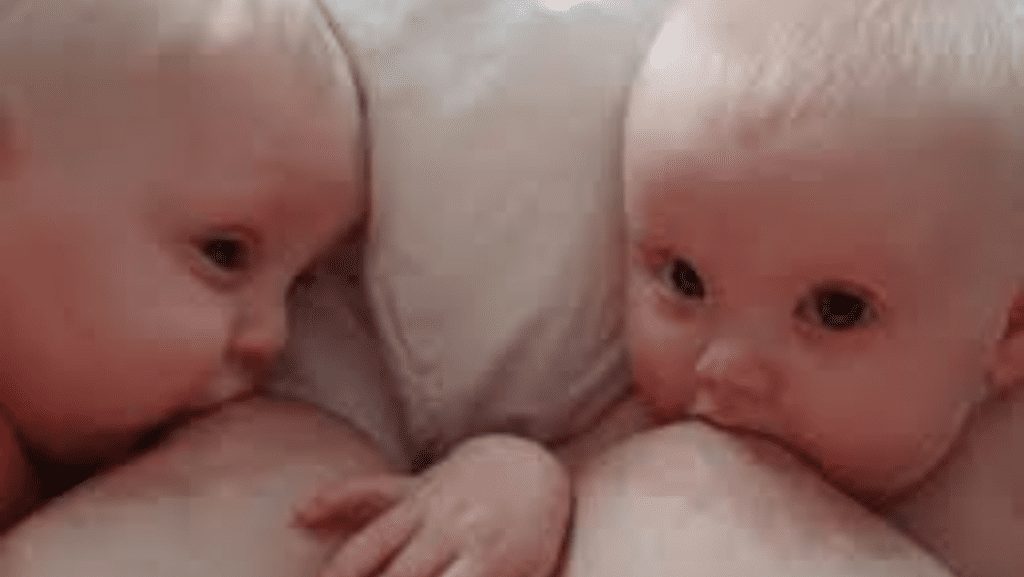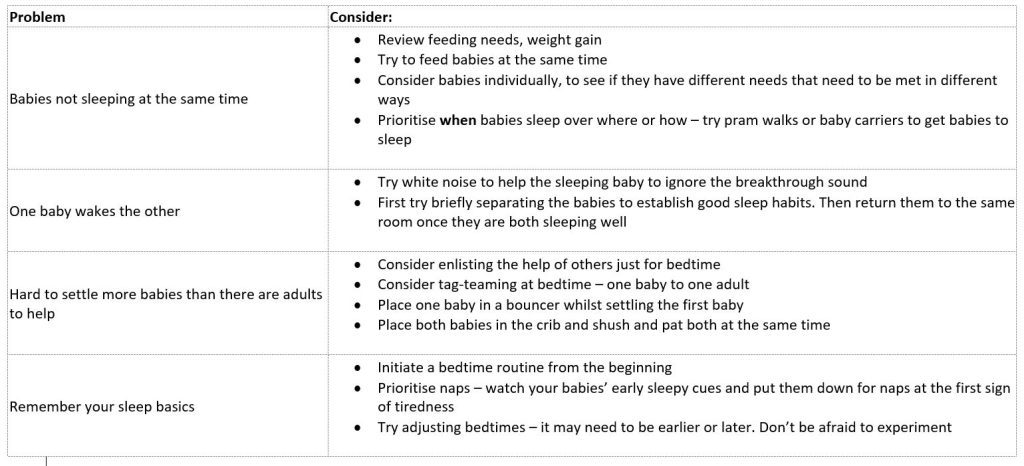
Sleep tips for multiples are not always the same as those for singletons. I’m not saying that multiple babies always bring exponentially more sleep problems! In fact, some people find that their multiples were easier than their singletons! But many families find that general sleep books contain tips that don’t always work very well with multiples.
I’ve teamed up with the fantastic Kathryn Stagg, breastfeeding counsellor, soon to be IBCLC and mum of twins as well as singletons to bring together our collective wisdom on sleep tips for multiples.
In the early days
The best time to lay the foundations for good sleep with multiples babies is in the newborn period. Prevention is better than cure after all! There are several strategies for families of multiples that are simply not an option for singleton newborns.
- Multiples are often smaller and born a little earlier than singleton babies. For these reasons, they often stay a little longer in hospital. Use this time to access as much support as possible for feeding, especially getting breastfeeding established. Many of the problems with low blood sugars, excessive weight loss and jaundice can be minimized or even avoided completely by frequent, effective feeding.
- Plan to feed your babies at least 10-12 times in 24 hours
- Try to not allow your babies a gap between feeds of any longer than 3 hours to avoid them dropping their blood sugars and becoming sleepy, cold or jaundiced
- Ensure your babies are drinking effectively at the breast, and not just latching on and then having a nap! Watch this video to see what really effective feeding looks like.
- Ask for help from the infant feeding team, peer supporters, a breastfeeding counsellor, or IBCLC – check this interactive map to find your nearest.
- Very young babies are not great at maintaining their body temperature. Dress your babies in thin, 100% cotton layers, but remember to avoid using a hat indoors unless you have been advised to use one by your baby’s medical team.
- Consider placing your babies in the same crib for sleep, ensuring that they are still in the back to sleep and feet to foot position. Twins and triplets are often comforted by being near their sibling(s). for more information click here.
- If your babies fall asleep feeding on a feeding cushion, then provided you are awake and watching them, just leave them where they are! Lots of babies wake up when they are transferred. At first, the priority is getting your babies to sleep simultaneously, rather than get them to sleep in their cot.
- If your babies like to take their time feeding, consider tandem feeding, where you feed them at the same time. Try watching this video for some inspiration with positions and how to manage more than one baby for feeds.
- Use a variety of sleep cues from the very beginning to encourage your babies to associate several cues with sleep. These could include shushing, patting, white noise, and a small thin muslin cloth with your scent on.
What sleep problems may occur?
To some extent, multiples are no different than singletons – they still enjoy being close to their parents, being cuddled, rocked, and fed to sleep. Nothing new there! The specifically tricky thing with more than one baby is managing the logistics!

Points to remember:
You gave birth to two, three or more completely individual little people. They may share many characteristics, features, and parents. However, that does not mean they will have the same sleep requirements, or go to sleep in the same way. Just as with a single baby, it is not your responsibility to make your babies sleep. It is only your responsibility to keep them loved and safe and provide the right environment for sleep.
If you do reach the utopian scenario when your babies are sleeping at the same time, in spite of the excitement you will feel at having achieved such a miracle, try to sleep! Resist the urge to catch up on your social media, laundry or batch cooking. The babies can sit in a bouncy chair watching you while you do those things. Sleep is a precious commodity – guard yours with your life!
Learn how to wrap your babies in a sling/baby carrier – this can be a lifesaver for when you need to get chores done, or you want your babies to sleep whilst you’re out and about. It’s well worth going to a sling library or asking a trained sling consultant to help you find the right sling – not all babies and mums get on with the same slings.
Remember the basics:
- Bedtime routine (do 3-4 calming activities that are predictable before each and every sleep, and do a mini-version of the routine for naps as well)
- Good sleep hygiene (uncluttered sleep environment, dim lighting, regular bedtime, bedtime routine)
- Learn your little one’s unique cues for tiredness, boredom, discomfort and other emotional and behavioural states.
- Stay calm! Babies are masters at knowing our psychological state. You have to be wise to this and plan to mentally ‘park’ your baggage prior to trying to get your little ones to fall asleep. If they sense your frustration or desperation, chances are they will get worked up and be harder to settle. I often recommend a thought or mood journal to dump any unhelpful or negative thinking patterns.
Some gadgets that may help:
The choice of baby equipment can be overwhelming, but here are some favourite gadgets from mums of multiples:
- Feeding pillows can be really useful – not only for feeding babies, but also to use for support, playtime and sitting up in bed. Check out Kathryn’s blog on feeding pillows here.
- Large side-car cots. There are loads on the market, and they facilitate breastfeeding and easier nighttime settling. If you don’t want to buy a specific co-sleeper crib, your other option is to buy a standard cot. Then take one of the long sides off, so that the cot only has 3 sides. Your babies can then sleep together in the cot.
- Bouncers – these can be a lifesaver as a safe place to put one baby while you attend to the other(s). There are lots to choose from – pick one that has head support so your baby’s head is not slumped, which can cause flat head syndrome.
- Twin buggies with carrycots. This is probably your most expensive purchase! However, if you have a pram with easily removable carrycots, your babies will be more portable. You can then meet friends out and about whilst your babies nap. If they only nap in their cot you may have a tricky situation where you are forced to be housebound for all their naps – not great for your social life or mental health!
Lyndsey Hookway is a paediatric nurse, health visitor, IBCLC, holistic sleep coach, PhD researcher, international speaker and author of 3 books. Lyndsey is also the Co-founder and Clinical Director of the Holistic Sleep Coaching Program, co-founder of the Thought Rebellion, and founder of the Breastfeeding the Brave project. Check Lyndsey’s speaker bio and talk brochure, as well as book her to speak at your event by visiting this page. All Lyndsey’s books, digital guides, courses and webinars can be purchased here, and you can also sign up for her free monthly newsletter here.

Leave A Comment
You must be logged in to post a comment.